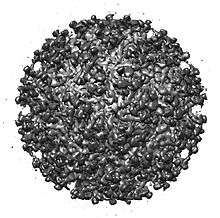Everglades virus
Everglades virus (EVEV) is an alphavirus included in the Venezuelan equine encephalitis virus complex. The virus circulates among rodents and vector mosquitoes and sometimes infects humans, causing a febrile illness with occasional neurological manifestations.[2][3] The virus is named after the Everglades, a region of subtropical wetlands in southern Florida. The virus is endemic to the U.S. state of Florida, where its geographic range mirrors that of the mosquito species Culex cedecei.[2] Hispid cotton rat and cotton mouse are considered important reservoir hosts of Everglades virus. Most clinical cases of infection occur in and around the city of Miami.[3]
| Everglades virus | |
|---|---|
 | |
| CryoEM reconstruction of the Everglades Virus. EMDB entry EMD-5563[1] | |
| Virus classification | |
| (unranked): | Virus |
| Realm: | Riboviria |
| Kingdom: | Orthornavirae |
| Phylum: | Kitrinoviricota |
| Class: | Alsuviricetes |
| Order: | Martellivirales |
| Family: | Togaviridae |
| Genus: | Alphavirus |
| Species: | Everglades virus |
Signs and symptoms
Symptoms of infection include:[4]
- Enlarged, tender lymph nodes
- Fever
- Headache
- Malaise
- Myalgia
- Pharyngitis
Transmission
The virus is transmitted by the bite of infected mosquitoes of the genus Culex,[5] specifically Culex cedecei.[2][6]
References
- Sherman, M. B.; Trujillo, J.; Leahy, I.; Razmus, D.; Dehate, R.; Lorcheim, P.; Czarneski, M. A.; Zimmerman, D.; Newton, J. T. A. M.; Haddow, A. D.; Weaver, S. C. (2013). "Construction and organization of a BSL-3 cryo-electron microscopy laboratory at UTMB". Journal of Structural Biology. 181 (3): 223–233. doi:10.1016/j.jsb.2012.12.007. PMC 3593667. PMID 23274136.
- Coffey, L.; Crawford, C.; Dee, J.; Miller, R.; Freier, J.; Weaver, S. (2006). "Serologic Evidence of Widespread Everglades Virus Activity in Dogs, Florida". Emerging Infectious Diseases. 12 (12): 1873–1879. doi:10.3201/eid1212.060446. PMC 3291350. PMID 17326938.
- Coffey, L. L.; Carrara, A. S.; Paessler, S.; Haynie, M. L.; Bradley, R. D.; Tesh, R. B.; Weaver, S. C. (2004). "Experimental Everglades Virus Infection of Cotton Rats (Sigmodon hispidus)". Emerging Infectious Diseases. 10 (12): 2182–2188. doi:10.3201/eid1012.040442. PMC 3323382. PMID 15663857.
- Calisher, C. H.; Murphy, F. A.; France, J. K.; Lazuick, J. S.; Muth, D. J.; Steck, F.; Lindsey, H. S.; Bauer, S. P.; Buff, E. E.; Schneider, N. J. (1980). "Everglades virus infection in man, 1975". Southern Medical Journal. 73 (11): 1548. doi:10.1097/00007611-198011000-00044. PMID 7444536.
- Williams, M. R.; Savage, H. M. (2009). "Identification of Culex (Melanoconion) species of the United States using female cibarial armature (Diptera: Culicidae)". Journal of Medical Entomology. 46 (4): 745–752. doi:10.1603/033.046.0404. PMID 19645276.
- Weaver, S. C.; Scherer, W. F.; Taylor, C. A.; Castello, D. A.; Cupp, E. W. (1986). "Laboratory vector competence of Culex (Melanoconion) cedecei for sympatric and allopatric Venezuelan equine encephalomyelitis viruses". The American Journal of Tropical Medicine and Hygiene. 35 (3): 619–623. doi:10.4269/ajtmh.1986.35.619. PMID 3706626.